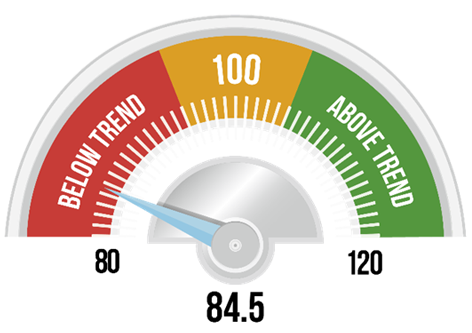The World Trade Organization’s (WTO) latest Goods Trade Barometer reading fell to 84.5—the lowest on record since 2007, and on par with the nadir of the 2008-09 financial crisis.
The current reading, released August 19, is 15.5 points below the baseline value of 100 for the index and 18.6 points down from the same period last year.
World merchandise trade likely registered a historic fall in the second quarter of 2020, according to the barometer, a real-time gauge of trends in global trade.
All of the barometer’s component indices remain well below trend, with many registering historic lows, although some have begun to stabilize, said WTO.
Indices for automotive products (71.8) and air freight (76.5) are by far the worst on record since 2007. Container shipping (86.9) also remains deeply depressed. Export orders (88.4) show signs of recovery as this index has turned upward. Meanwhile, indices for electronic components (92.8) and agricultural raw materials (92.5) have held up relatively well, showing only modest declines.
The latest reading is broadly consistent with WTO statistics issued in June, which estimated an 18.5% decline in merchandise trade in the second quarter of 2020 as compared to the same period last year.
The WTO’s June statistics implied a 14% drop in global merchandise trade volume between the first and second quarters of this year. This estimate, together with the new Goods Trade Barometer reading, suggests that world trade in 2020 is evolving in line with the less pessimistic of the two scenarios outlined in the WTO’s April forecast, which projected that the volume of merchandise trade this year would contract by 13% compared to 2019.
However, the heavy economic toll of the COVID-19 pandemic suggests that the projections for a strong, V-shaped trade rebound in 2021 may prove overly optimistic.
“As uncertainty remains elevated, in terms of economic and trade policy as well as how the medical crisis will evolve, an L-shaped recovery is a real prospect. This would leave global trade well below its pre-pandemic trajectory,” said WTO.
An L-shaped recovery is a type of recovery characterized by a slow rate of recovery, with persistent unemployment and stagnant economic growth.
The number of commercial flights per day recorded by the OpenSky Network since the start of 2020 shows that flights worldwide fell nearly 80% between late February and mid-April, with international flights declining more than domestic ones. Flight totals have gradually recovered through the end of July but remain around 40% below their level at the start of the year. Commercial flights are an important indicator of the state of the global economy since they are closely related to both goods and services trade.
Weekly port calls of container ships dipped sharply in February 2020 when the severity of the COVID-19 virus became apparent, then rebounded before falling again in April-May as the disease spread more widely. Port calls of container ships were still down around 7% year-on-year at the beginning of August, marking a modest improvement over the 11% decline registered in May.
Meanwhile copper futures were down 27% in mid-March compared to the start of the year but have since risen 37%, reflecting rising expectations of economic recovery. Whether these expectations are well founded will depend on the course of the COVID-19 pandemic, including second waves of infection and improved treatment options, said WTO.
The Goods Trade Barometer is designed to gauge momentum and identify turning points in world trade growth. Readings of 100 indicate growth in line with medium-term trends; readings greater than 100 suggest above-trend growth, while those below 100 indicate below-trend growth.
Image courtesy of WTO









